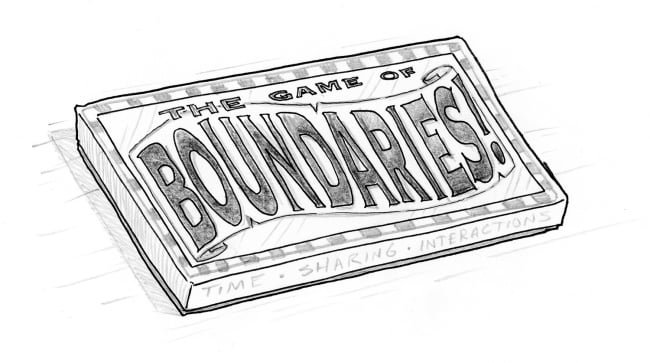You have /5 articles left.
Sign up for a free account or log in.

Ed Himelblau
Boundary-related issues are a challenge for any college teacher but are especially acute for teaching assistants. TAs tend to be novice teachers and may differ in age by only a year or two from the students they instruct. A discussion of boundaries—how to make and maintain them—that is specific to TAs is needed. This piece attempts to start that discussion.
Imagine the following situation. On your first day as a TA, you receive a copy of a game called “Boundaries!” You open the box and find three piles of cards labeled “Time,” “Sharing” and “Interactions.” Shuffling through the cards, you see that a scenario involving students is written on each. Cards from the time pile have scenarios like, “Student requests to meet outside of scheduled office hours,” and, “Respond to student emails during the weekend.” The top card on the sharing pile says, “Answer questions about my partner/relationships.” A card from the interaction pile says, “Accept an invitation to a student party.”

Ed Himelblau
The box contains a game board. You unfold it and discover that two areas are labeled “I’m OK with it” and “I’m not OK with it.” A third area is labeled “Never OK!” Looking closely at the “Never OK!” area, you see a list of serious-sounding stuff like, “Tolerate aggressive behavior” and “Gossip about students and faculty.”
Intrigued, you flip over the lid of the box to read the rules. You are surprised to find only one instruction: “Place the cards on one side of the board or the other.” That’s it! Did you miss something? You search the box but, no, those are the only guidelines.
How do you expect students to interact with you? How much time and energy will you invest in your teaching? How much of yourself will you share with students? These are some of the boundary-related questions a new TA must consider—and often with little guidance. The advice TAs do receive about interacting with students is often limited to institutional policies regarding romantic or sexual relationships—not about challenges related to boundaries.
Boundary challenges can take the form of students being pushy or arguing about grades and class policies. They may take the form of students acting too informally toward their TA—joking inappropriately, teasing or just generally not respecting the student-teacher relationship. In another form of boundary crossing, students may see the TA as a person to whom they can disclose emotional information about themselves. As a TA, you may feel honored that a student feels safe sharing their feelings, but listening and empathizing is not without time and energy costs.
Many TAs feel tension between the demands of teaching and honoring their own personal and professional needs. They want to be available for students who need help, but they have limited time and a lot to do. They wish to be flexible in terms of assignments, but they worry that some students will take advantage of that flexibility. They want the classroom to feel friendly and welcoming, but are concerned that some individuals won’t recognize their authority.
Back to the board game. You pull a card from the Interaction pile. It reads, “Give students my personal phone number.” You have heard of instructors who were willing to give out their cell number. But to you, a text or call from a student would feel unwelcome. That’s a boundary you want to preserve, so you place the card on the I’m Not OK With It section of the board. The next card reads, “Greet students when you see them on campus.” It feels natural that you’d say hello if you bump into a student from your class. You place that card in the I’m OK With It section. You pull more cards and keep sorting.
It’s also important to take a close look at the part of the board labeled “Never OK!”—which could include students dropping by your office at any time or expecting immediate email responses, gossiping about students or faculty members, aggressive behavior or offensive language, or various other interactions that are never appropriate in an educational setting.
Do not engage in or tolerate any of these. At any point during teaching, if you are subjected to aggressive, offensive or disrespectful student behavior, seek help and advice from your course coordinator, faculty mentor or department chair.
The board game analogy is intended to emphasize that defining boundaries is a process involving many small decisions and that those decisions are personal and changeable. Over time, as you gain a sense of your own comfort levels with different situations, you can adjust your boundaries—you can move cards! A card placed in I’m Not OK With It could move into I’m OK With It as your experience working with students grows. Alternatively, you can decide that something you might have originally considered OK is not a good choice for you and move that card to the I’m Not OK With It area.
In short, defining boundaries is an ongoing process. When a new request for time, sharing or interaction arises, you’ll think it through and figure out where to place that card on the board, knowing that you can move it later if it’s not working for you.
Defining Boundaries

Ed Himelblau
As a TA, how should you define your boundaries to students? What do you say when you need to defend a boundary that has been crossed by a student? And how might your identity influence the nature of the boundary challenges you might face?
The best time to establish boundaries is early in the term and especially on the first day. You will be more relaxed, and you will provide better guidance for students if you start the term with a good idea of what you are OK with and not OK with.
Communicating your boundaries begins when students enter the classroom. Some students may not be sure of your role or how to interact with you. When you greet students in a friendly yet formal way you establish the teacher-student relationship. By saying, “Welcome! Please have a seat anywhere,” or “Nice to meet you. Please tell me your name,” you are being welcoming while also making it clear that you are the person in charge of the classroom.
Once class begins, you will continue to clarify your role and communicate your boundaries. Take a simple example: How do you want to be addressed? Students could be confused about this. Do they call you “professor,” or are you on a first-name basis? On the first day of class, let the students know through a clear statement: “Please call me [name or title—whatever you prefer].” Through that simple announcement you have begun to establish that you and the students have different roles in the classroom that must be respected.
A statement about email communication can also serve this purpose. You might say to the class, “I do my best to respond to email questions within 24 hours on weekdays. If you haven’t heard back from me within that time frame, please send a follow-up email.” The underlying message is that boundaries exist, and both you and the students have roles and responsibilities.
TAs must find a balance between being friendly with students versus trying to be their friend. Go into the class with the mindset that you want to be thought of as one of them and you blur boundaries between yourself and the students. What if you need to deal with a case of cheating or plagiarism later in the term? What if you need to enforce a class policy regarding late work? Perceptions of friendship complicate these interactions.
If a TA is a similar age to the students in their class, some students may misinterpret roles and boundaries. For example, a student who wouldn’t joke around with an older faculty member in class might think it’s OK to do so with you. They may wrongly think of you as a peer, rather than as a teacher, simply because you look to be about their age. But you’re not their peer, and you may need to address this boundary-crossing student behavior using some of the ideas below.
Maintaining Boundaries
You arrive on campus looking forward to a day with no scheduled teaching or office hours. You have experiments to tend to, papers to read and a presentation to work on. As you sit down at your desk, you hear “Hello?” and see Michael, a student in your class, peeking in the door.
“Hi, Michael. What’s up?” you ask.
“I was wondering if I could ask you a few quick questions about my lab report,” he answers.
Michael has crossed a boundary by showing up at your office outside of your scheduled hours. As you read about this scenario, it may seem to be an easy call—you would not agree to this request to give up your dedicated research time. But in the moment, with the student standing in front of you, it might not seem so easy.
When in-the-moment decisions about boundaries come up, take a mindful pause before you respond. Ask yourself how this thing you are considering—like a request for your time—contributes or detracts from your goals. Maybe Michael’s question will only take a few minutes to answer, but what about the next time he shows up? Do you want this one-time interruption to become a regular thing? If you constantly give up your time, you’ll signal to students that you are always available, detracting from your research and stressing you out. Briefly pausing to distance yourself from the situation can remind you of the importance of your boundaries and prepare you for the next step in the conversation.
“I can’t help you now,” you say. “I have office hours tomorrow at 10 a.m. I’d be happy to help you then. Or if you want to email your questions to me, I’ll do my best to respond today.”
Alternatively, if you are willing to provide Michael with a quick answer now, do so and follow up with, “In the future, please contact me before coming to my office or save your questions for office hours.”
Here’s more advice for having boundary-related conversations, which I’ve adapted from Amanda Wyrick, associate professor of biology at Berea College.
Be direct. Clarify what is and isn’t OK in your relationship with a student. Keep it simple. For example:
- “I’m not comfortable discussing this topic.”
- “Your jokes weren’t appropriate for class.”
- “When I ask the class for attention, please stop your conversations to avoid delays.”
- “It’s unfair to the other students in the class for you to continue asking for extensions to assignments.”
Don’t be apologetic. You don’t need to apologize when you maintain boundaries or start these conversations with statements like, “I’m probably being too sensitive but …” or “I know some instructors are OK with this but …” Qualifying boundary-defining statements in this way makes the message less clear.
Avoid calling the student out. Conduct such discussions with students privately in person or on email whenever possible. If you must address a boundary during class, try to do it discreetly, as the student will be more open to hearing what you have to say if their peers aren’t privy to it.
It’s important to recognize that issues around boundaries may affect some TAs differently than others due to age, gender, race or ethnicity. TAs who appear young, present as female and/or are from underrepresented groups may find that some students test their boundaries in ways that they don’t test TAs who are older, male or white. Student bias around gender, race and ethnicity in higher education is well documented. One study looking specifically at bias in teaching evaluations of TAs provided empirical evidence for the gender bias that young female TAs have experienced.
Kerry Ann Rockquemore provides helpful advice about the extra boundary-related challenges that some college teachers face specifically because of their identity, but her guidance rings true for TAs in general as well. “I’m not saying it’s fair that you may have to frequently defend your boundaries,” she concludes. “I’m saying that’s real, and it’s why you have to be extra clear about where your boundaries lie and skillfully push back when students cross them.”
The important thing is to make boundaries that honor your physical, mental and emotional limits. Blurry boundaries can lead to stress and boundary-pushing by students. Clear boundaries can enhance the quality of the mentorship you provide for students. To quote an experienced TA, “You want to keep your personal life out of it and put energy in to exposing students to your academic life—your research and your passion for the subject.”




